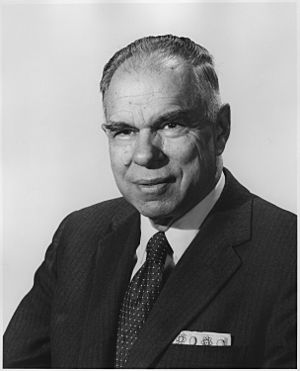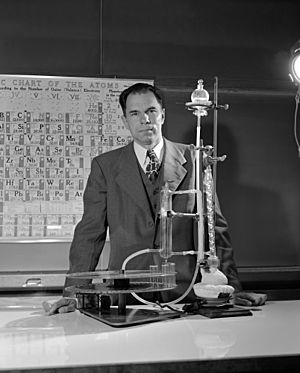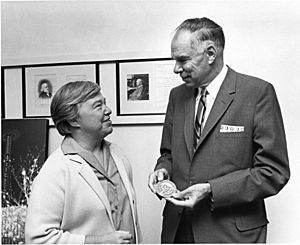Glenn T. Seaborg facts for kids
Quick facts for kids
Glenn T. Seaborg
|
|
|---|---|

Seaborg in 1964
|
|
| Born |
Glenn Theodore Seaborg
April 19, 1912 |
| Died | February 25, 1999 (aged 86) |
| Alma mater | |
| Known for | Contributions to the synthesis, discovery and investigation of ten transuranium elements |
| Awards |
|
| Scientific career | |
| Fields | Nuclear chemistry |
| Institutions | |
| Thesis | The interaction of fast neutrons with lead (1937) |
| Doctoral advisor |
|
| Doctoral students |
|
| Other notable students | Margaret Melhase |
| Chairman of the United States Atomic Energy Commission | |
| In office March 1, 1961 – August 16, 1971 |
|
| Preceded by | John McCone |
| Succeeded by | James R. Schlesinger |
| 2nd Chancellor of the University of California, Berkeley | |
| In office 1958–1961 |
|
| Preceded by | Clark Kerr |
| Succeeded by | Edward W. Strong |
| Signature | |
Glenn Theodore Seaborg (born April 19, 1912 – died February 25, 1999) was an American chemist. He helped create, find, and study ten transuranium elements. These are elements heavier than uranium. For this important work, he shared the 1951 Nobel Prize in Chemistry.
Seaborg also developed the idea of the actinide concept. This concept helped arrange the actinide series correctly on the periodic table of elements.
He spent most of his career at the University of California, Berkeley. He was a professor there and even served as the university's leader, called a chancellor, from 1958 to 1961. He advised ten US presidents, from Harry S. Truman to Bill Clinton, on nuclear topics. He was also the Chairman of the United States Atomic Energy Commission from 1961 to 1971. In this role, he promoted peaceful uses of nuclear science, like nuclear energy.
Seaborg worked hard for arms control, which means limiting nuclear weapons. He signed the Franck Report and helped create important treaties like the Limited Test Ban Treaty and the Nuclear Non-Proliferation Treaty. He also strongly supported science education and government funding for research.
Seaborg was the main discoverer or co-discoverer of ten elements: plutonium, americium, curium, berkelium, californium, einsteinium, fermium, mendelevium, nobelium, and seaborgium. Element 106, seaborgium, was named after him while he was still alive. He said this was the greatest honor he ever received, even better than the Nobel Prize. He hoped it would inspire students to learn about his work.
He also found over 100 different types of isotopes of transuranium elements. He made big contributions to the chemistry of plutonium, especially during the Manhattan Project. He developed a way to get plutonium fuel for the atomic bomb. Early in his career, he also helped create nuclear medicine. He discovered isotopes used to find and treat diseases, like iodine-131 for thyroid problems.
Besides his Nobel Prize, Seaborg received about 50 honorary doctorates and many other awards. Many things are named after him, from the element seaborgium to the asteroid 4856 Seaborg. He wrote many books and articles. He was even listed in the Guinness World Records for having the longest entry in Who's Who in America.
Contents
Early Life and Education
Glenn Theodore Seaborg was born in Ishpeming, Michigan, on April 19, 1912. His parents were Herman Theodore and Selma Olivia Erickson Seaborg. He had a younger sister, Jeanette. His family spoke Swedish at home. When Glenn was a boy, his family moved to Los Angeles County, California.
Seaborg started keeping a daily journal in 1927 and continued until 1998. As a young person, he loved sports and movies. His mother wanted him to be a bookkeeper, thinking his interest in books was not practical. He didn't get interested in science until high school. His chemistry and physics teacher, Dwight Logan Reid, at David Starr Jordan High School, inspired him.
Seaborg finished high school in 1929 as the top student. He earned a Bachelor of Arts (BA) degree in chemistry from the University of California, Los Angeles, in 1933. He paid for his schooling by working as a stevedore (someone who loads and unloads ships) and a lab assistant. He then got his PhD in chemistry from the University of California, Berkeley, in 1937. His doctoral paper was about how fast neutrons interact with lead. In this paper, he created the term "nuclear spallation", which means breaking apart an atomic nucleus.
As a student, Seaborg did research with his advisor Gilbert Newton Lewis. He also studied a book called Applied Radiochemistry by Otto Hahn. This book greatly influenced his interest in research. For several years, Seaborg did important research on artificial radioactivity using a machine called a cyclotron at UC Berkeley. He was excited to learn that nuclear fission (splitting an atom) was possible.
Seaborg also learned to talk effectively with physicist J. Robert Oppenheimer. Oppenheimer had a strong reputation and often answered questions before they were fully asked. Seaborg learned to ask his questions quickly and clearly.
Discovering New Elements

After getting his PhD, Seaborg stayed at the University of California, Berkeley, for more research. He studied isotopes, which are different forms of the same element. He helped discover more than 100 isotopes. In 1937, he and his colleagues used a cyclotron to create a new isotope of iron, iron-59. Iron-59 was useful for studying hemoglobin in human blood. In 1938, Seaborg and John Livingood created iodine-131. This isotope is still used to treat thyroid disease. Because of these and other discoveries, Seaborg is known as a pioneer in nuclear medicine.
In 1939, he became a chemistry instructor at Berkeley. He was promoted to assistant professor in 1941 and full professor in 1945. In 1940, physicist Edwin McMillan at UC Berkeley discovered element 93, which he named neptunium. McMillan then left Berkeley for a short time to work on radar technology. Seaborg and his team had improved McMillan's method for isolating neptunium. So, McMillan allowed Seaborg to continue the research and look for element 94.
In February 1941, Seaborg and his team created plutonium-239 by bombarding uranium. They saw that neptunium (element 93) was created, but it then changed into a new element, plutonium, with 94 protons. Plutonium was found to be fissile, meaning it could be split to release a lot of energy. This was a very important discovery for the Manhattan Project. On March 28, 1941, Seaborg, physicist Emilio Segrè, and chemist Joseph W. Kennedy showed that plutonium was fissile. In 1966, the lab where Seaborg did this work at Berkeley was named a US National Historic Landmark.
Besides plutonium, Seaborg is also credited with discovering americium, curium, and berkelium. He also helped discover californium, einsteinium, fermium, mendelevium, nobelium, and seaborgium. He shared the Nobel Prize in Chemistry in 1951 with Edwin McMillan for their discoveries of the first transuranium elements.
Work During the Manhattan Project
On April 19, 1942, Seaborg moved to Chicago to join the Metallurgical Laboratory for the Manhattan Project. This project was a secret effort to build the atomic bomb during World War II. At the University of Chicago, Enrico Fermi and his team were working to turn uranium-238 into plutonium-239. Seaborg's job was to figure out how to separate the tiny amount of plutonium from a large amount of uranium.
On August 20, 1942, plutonium-239 was isolated in amounts that could be seen. On September 10, 1942, it was weighed in Seaborg's lab. He was in charge of the complex chemical process to separate, concentrate, and isolate plutonium. This process was later used on a much larger scale at sites in Tennessee and Washington.
Seaborg's idea of the actinide concept led to a new way of drawing the periodic table. It placed the actinide series below the lanthanide series. While in Chicago, Seaborg also developed the elements americium and curium. He even got patents for both elements. Americium is now commonly used in household smoke detectors.
Before the first nuclear weapon was tested, Seaborg and other scientists wrote a statement called the Franck Report. They asked President Truman to show the atomic bomb to the Japanese in a public demonstration. This was to avoid using it in war, but their request was not successful.
Professor and University Leader

After World War II and the Manhattan Project, Seaborg wanted to go back to university life and research. In 1946, he became the head of nuclear chemistry research at the Lawrence Radiation Laboratory at the University of California. In 1947, he was named one of the "Ten Outstanding Young Men in America." He was elected to the Member of the National Academy of Sciences in 1948. From 1954 to 1961, he was an associate director at the radiation laboratory. President Truman also appointed him to advise the United States Atomic Energy Commission.
Seaborg was the chancellor of the University of California, Berkeley, from 1958 to 1961. During his time, rules about student expression became more relaxed. In October 1958, Seaborg announced that the university would allow more political activity. The ban on communists speaking on campus was also lifted. This helped set the stage for the Free Speech Movement in the 1960s.
Seaborg was a big fan of the university's sports teams. He was proud that the Cal Bears won their first and only national basketball championship in 1959 while he was chancellor. He also helped restore trust in college sports after a scandal.
He also advised President Dwight D. Eisenhower on science. In 1960, he helped write the "Seaborg Report," which asked for more government funding for science.

Leading the Atomic Energy Commission
In 1961, President John F. Kennedy appointed Seaborg as chairman of the Atomic Energy Commission (AEC). He held this position until 1971. During this time, he advised 10 US presidents. His appointment was almost stopped because an article wrongly linked him to Vice President Richard Nixon, a Republican. Seaborg, a lifelong Democrat, was confused by the article.
In the early 1960s, Seaborg worried about how nuclear weapons could affect the environment and human life. He asked the AEC to study these effects. His studies helped the US government look into developing "clean" nuclear weapons, which would cause less harm.
As AEC chairman, Seaborg was part of the team that negotiated the Limited Test Ban Treaty (LTBT). In this treaty, the US, UK, and USSR agreed to ban all nuclear weapon tests above ground. Seaborg felt this was one of his greatest achievements. He even secretly took a photo of Soviet Premier Nikita Khrushchev signing the treaty.
Seaborg had a good relationship with President Lyndon B. Johnson. He influenced Johnson's administration to pursue the Nuclear Non-Proliferation Treaty. He also advised President Richard Nixon on nuclear issues.
During his time at the AEC, Seaborg published several books and articles. He predicted that elements beyond those on the periodic table, called transactinide and superactinide series, would exist. He also thought there might be a stable "island of stability" for some very heavy elements. He served as chairman of the Atomic Energy Commission until 1971.
Return to California

After leaving the Atomic Energy Commission, Seaborg returned to UC Berkeley. He was given the special title of University Professor. He also led the Lawrence Hall of Science, where he worked on a science education program called Great Explorations in Math and Science (GEMS). He was president of the American Association for the Advancement of Science in 1972 and the American Chemical Society in 1976.
In 1980, he changed a small amount of bismuth-209 into gold at the Lawrence Berkeley National Laboratory. He used nuclear physics to remove protons and neutrons from the bismuth atoms. This process was too expensive for making gold regularly, but it was a scientific achievement.
In 1981, Seaborg became a founding member of the World Cultural Council.
In 1983, President Ronald Reagan asked Seaborg to join the National Commission on Excellence in Education. This commission wrote a report called "A Nation at Risk: The Imperative for Educational Reform". This report brought national attention to education as an important issue for the government.
Seaborg lived most of his later life in Lafayette, California. He spent time editing and publishing his journals, which documented his life and career. He also gathered scientists to criticize California's science curriculum. He felt it focused too much on social topics and not enough on hard science. California Governor Pete Wilson appointed Seaborg to lead a committee that suggested changes to the science curriculum.
Personal Life
In 1942, Seaborg married Helen Griggs, who was the secretary of physicist Ernest Lawrence. They were engaged when Seaborg moved to Chicago for his wartime work. When Seaborg returned to bring Helen to Chicago, they decided to get married right away. They got off the train in Caliente, Nevada, thinking it would be a quick wedding. But Caliente didn't have a City Hall, so they had to travel 25 miles north to Pioche. A deputy sheriff, who had studied chemistry at Berkeley, helped them by arranging a ride in a mail truck. They were married with a clerk and a janitor as witnesses. Glenn and Helen Seaborg had seven children.
Seaborg loved hiking. When he became Chairman of the Atomic Energy Commission in 1961, he started taking daily hikes on a trail he made near his office in Germantown, Maryland. He often invited colleagues and visitors to join him. This trail became known as the "Glenn Seaborg Trail." He and his wife Helen also created a 12-mile trail near their home in Lafayette, California. This trail is now part of a cross-country network of trails.
Seaborg was elected a foreign member of the Royal Swedish Academy of Sciences in 1972. He also became a Foreign Member of the Royal Society of London in 1985. He was honored as Swedish-American of the Year in 1962. He kept a strong connection to his Swedish heritage and visited Sweden often.
Death
On August 24, 1998, while at a meeting in Boston, Seaborg had a stroke. He passed away six months later, on February 25, 1999, at his home in Lafayette.
Awards and Honors
Glenn Seaborg wrote or co-wrote many books and 500 scientific articles. Many of these were quick reports on new discoveries in nuclear science. Others, like the actinide concept, were major ideas in the history of science. He held over 40 patents, including the only patents ever given for chemical elements, americium and curium. He received more than 50 honorary degrees. At one point, he was in the Guinness Book of World Records for having the longest entry in Marquis Who's Who in America. In 2005, he was added to the National Inventors Hall of Fame.
Seaborg was elected to the United States National Academy of Sciences in 1948. He also became a member of the American Philosophical Society in 1952 and the American Academy of Arts and Sciences in 1958.
The element seaborgium was named after Seaborg by Albert Ghiorso and others. It was named while Seaborg was still alive, which was a bit unusual. He had influenced the naming of so many elements that when seaborgium was announced, a magazine noted that he could receive a letter addressed using chemical elements: seaborgium, lawrencium (for the lab where he worked), berkelium, californium, americium. Seaborgium is the first element ever officially named after a living person. The second is oganesson, named in 2016 after Yuri Oganessian.
Images for kids
See also
 In Spanish: Glenn T. Seaborg para niños
In Spanish: Glenn T. Seaborg para niños



